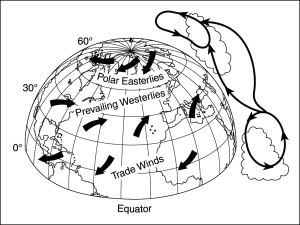The theory of weather is a complex yet intriguing topic to discuss. It’s often joked that by the time you complete training you’re an amateur meteorologist. Joke or not, that statement is fairly accurate. Weather can be one of the key factors in determining a go/no-go decision and to make an accurate assessment it is important for the pilot in command to understand the full spectrum of what causes weather.
Let’s start with the most basic and determine the overall source of where weather comes from. Below is an excerpt from ASA’s 2015 Private Pilot Test Prep.
The major source of all weather is the sun. Changes or variations of weather patterns are caused by the unequal heating of the Earth’s surface. Every physical process of weather is accompanied by or is a result of unequal heating of the Earth’s surface.
The heating of the Earth (and therefore the heating of the air surrounding the Earth) is unequal around the entire planet. Both north or south of the equator, one square foot of sunrays is not concentrated over one square foot of the surface, but over a larger area. This lower concentration of sunrays produces less radiation of heat over a given surface area; therefore, less atmospheric heating takes place in that area.
The unequal heating of the Earth’s atmosphere creates a large air-cell circulation pattern (wind) because the warmer air has a tendency to rise (low pressure) and the colder air has a tendency to settle or descend (high pressure) and replace the rising warmer air. This unequal heating, which causes pressure variations, will also cause variations in altimeter settings between weather reporting points.
Because the Earth rotates, this large, simple air-cell circulation pattern is greatly distorted by a phenomenon known as the Coriolis force. When the wind (which is created by high pressure trying to flow into low pressure) first begins to move at higher altitudes, the Coriolis force deflects it to the right (in the Northern Hemisphere) causing it to flow parallel to the isobars (lines of equal pressure). These deflections of the large-cell circulation pattern create general wind patterns as depicted in the figure below.
Let’s take a look at a few questions you might encounter on your FAA Private Pilot Knowledge Test. I will post the answers Monday morning in the comments section.
1. Every physical process of weather is accompanied by, or is the result of, a
A—movement of air.
B—pressure differential.
C—heat exchange.
2. What causes variations in altimeter settings between weather reporting points?
A—Unequal heating of the Earth’s surface.
B—Variation of terrain elevation.
C—Coriolis force.





